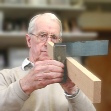

It is often useful to slew a plane so that the edge makes an angle with the track of its movement. When this happens the effective cutting angle is reduced, as indicated below. However, it is apparent that for a convenient angle, say 20°, this change is not very significant.
However, the likely reduction inSkitter and Chatteris probably the greatest benefit to be gained.
One disadvantage is that since the forward and rear-most hands are out of alignment, the plane is a little more difficult to control.
Another effect (that can be an advantage or a disadvantage) can be that when operating on a narrow edge, the effective length of a plane is reduced.
| Degrees | Angle reduction | Percent change |
|---|---|---|
| 10 | 0.5 | 1.1 |
| 20 | 1.5 | 3.3 |
| 25 | 3 | 6.6 |
| 30 | 4 | 8.8 |
| 40 | 7 | 17.5 |
| 45 | 10 | 22.2 |
From these figures it is apparent that a slew angle for a chisel, say when paring horizontally, of 25° will gain a 10% advantage in the form of a 'sharper' edge. Usually people seem to skew the track of the chisel rather than slew its actual edge. As they slide the chisel sideways, some micro-sawing effect might occur since on a microscopic scale the edge will be somewhat ragged, especially as it begins to blunt.
| Degrees | Angle reduction | Percent change |
|---|---|---|
| 10 | 3/4 | 2.5 |
| 20 | 3.25 | 10.8 |
| 30 | 3.5 | 11.5 |
| 40 | 6.5 | 21 |
| 45 | 8 | 26 |
This table is just for the curious.
| Slew angle | Shaving width (%) |
|---|---|
| 5 | 99.6 |
| 10 | 98.5 |
| 15 | 96.5 |
| 20 | 93.9 |
| 25 | 90.6 |
| 30 | 86.6 |
| 35 | 81.9 |
| 40 | 76.6 |